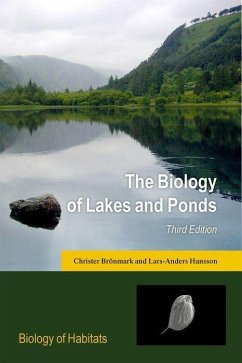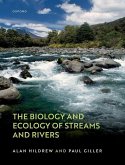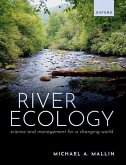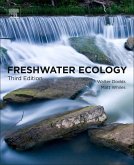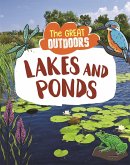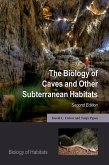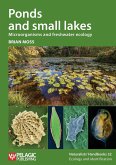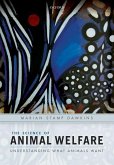Christer Bronmark (Professor, Professor, Aquatic Ecology Unit, Depa, Lars-Anders Hansson (Professor, Professor, Aquatic Ecology Unit, De
The Biology of Lakes and Ponds
Christer Bronmark (Professor, Professor, Aquatic Ecology Unit, Depa, Lars-Anders Hansson (Professor, Professor, Aquatic Ecology Unit, De
The Biology of Lakes and Ponds
- Broschiertes Buch
- Merkliste
- Auf die Merkliste
- Bewerten Bewerten
- Teilen
- Produkt teilen
- Produkterinnerung
- Produkterinnerung
A concise but comprehensive introduction to the biology of standing waters (lakes and ponds). As with other books in the Biology of Habitats Series, the emphasis in this book is on the organisms that dominate freshwater environments. Management and conservation aspects are also considered.
Andere Kunden interessierten sich auch für
![The Biology and Ecology of Streams and Rivers The Biology and Ecology of Streams and Rivers]() Alan Hildrew (Professor of Ecology, Professor of Ecology, School ofThe Biology and Ecology of Streams and Rivers49,99 €
Alan Hildrew (Professor of Ecology, Professor of Ecology, School ofThe Biology and Ecology of Streams and Rivers49,99 €![River Ecology River Ecology]() Prof Michael A. Mallin (Research Professor, Research Professor, BioRiver Ecology49,99 €
Prof Michael A. Mallin (Research Professor, Research Professor, BioRiver Ecology49,99 €![Freshwater Ecology Freshwater Ecology]() Walter K. DoddsFreshwater Ecology118,99 €
Walter K. DoddsFreshwater Ecology118,99 €![The Great Outdoors: Lakes and Ponds The Great Outdoors: Lakes and Ponds]() Lisa ReganThe Great Outdoors: Lakes and Ponds11,99 €
Lisa ReganThe Great Outdoors: Lakes and Ponds11,99 €![The Biology of Caves and Other Subterranean Habitats The Biology of Caves and Other Subterranean Habitats]() David C. Culver (Profe Professor Emeritus of Environmental ScienceThe Biology of Caves and Other Subterranean Habitats58,99 €
David C. Culver (Profe Professor Emeritus of Environmental ScienceThe Biology of Caves and Other Subterranean Habitats58,99 €![Ponds and small lakes Ponds and small lakes]() Brian MossPonds and small lakes42,99 €
Brian MossPonds and small lakes42,99 €![The Science of Animal Welfare The Science of Animal Welfare]() Marian Stamp Dawkins (Professor of A Professor of Animal BehaviourThe Science of Animal Welfare42,99 €
Marian Stamp Dawkins (Professor of A Professor of Animal BehaviourThe Science of Animal Welfare42,99 €-
-
-
A concise but comprehensive introduction to the biology of standing waters (lakes and ponds). As with other books in the Biology of Habitats Series, the emphasis in this book is on the organisms that dominate freshwater environments. Management and conservation aspects are also considered.
Produktdetails
- Produktdetails
- Biology of Habitats Series
- Verlag: Oxford University Press
- 3 Revised edition
- Seitenzahl: 368
- Erscheinungstermin: 19. Oktober 2017
- Englisch
- Abmessung: 233mm x 154mm x 22mm
- Gewicht: 640g
- ISBN-13: 9780198713609
- ISBN-10: 0198713606
- Artikelnr.: 48224194
- Biology of Habitats Series
- Verlag: Oxford University Press
- 3 Revised edition
- Seitenzahl: 368
- Erscheinungstermin: 19. Oktober 2017
- Englisch
- Abmessung: 233mm x 154mm x 22mm
- Gewicht: 640g
- ISBN-13: 9780198713609
- ISBN-10: 0198713606
- Artikelnr.: 48224194
Christer Brönmark completed his undergraduate studies as well as his Ph.D. thesis at Lund University. After defending his Ph.D. in 1985 he did a post doc at Ohio State University, Columbus and then returned to Lund University where he now has a position as Professor of Aquatic Ecology. His research interest deals with the predation in freshwater systems at different organisational levels, from effects on individual behaviour and inducible defence adaptations to indirect interactions in food webs at the community level. At present he is working with the causes and consequences of partial migration in freshwater fish and proximate mechanisms behind the expression of inducible defences. He regularly teaches courses on population and community ecology, aquatic ecology, and limnology. Lars-Anders Hansson's Ph.D. thesis dealt with competitive interactions among primary producers and was defended in 1989. Thereafter he spent some years as a post-doc focussing on aquatic food web interactions and on habitat shifts by algae and zooplankton from sediment to water. Most of his studies have been carried out in Europe, but he has also worked in the USA, as well as in polar regions, such as Siberia, Alaska, Canada, and Antarctica. Specifically he has studied how zooplankton utilize their morphological and behavioural plasticity to handle simultaneous multiple threats and has used nanotechnology to track the behaviour of individual animals. Although his main interest has been within curiosity driven, research, he also has an interest in more applied issues, such as the possibility of restoring aquatic ecosystems, how to handle effects from climate change, and how novel environmental threats, such as the immense use of nanosized particles, may affect aquatic ecosystems.
1: Introduction
2: The abiotic frame and adaptations to cope with abiotic constraints
3: The organisms: the actors within the abiotic frame
4: Biotics: competition, herbivory, predation, parasitism, and symbiosis
5: Food web interactions in freshwater ecosystems
6: Biodiversity and environmental threats
2: The abiotic frame and adaptations to cope with abiotic constraints
3: The organisms: the actors within the abiotic frame
4: Biotics: competition, herbivory, predation, parasitism, and symbiosis
5: Food web interactions in freshwater ecosystems
6: Biodiversity and environmental threats
1: Introduction
2: The abiotic frame and adaptations to cope with abiotic constraints
3: The organisms: the actors within the abiotic frame
4: Biotics: competition, herbivory, predation, parasitism, and symbiosis
5: Food web interactions in freshwater ecosystems
6: Biodiversity and environmental threats
2: The abiotic frame and adaptations to cope with abiotic constraints
3: The organisms: the actors within the abiotic frame
4: Biotics: competition, herbivory, predation, parasitism, and symbiosis
5: Food web interactions in freshwater ecosystems
6: Biodiversity and environmental threats

